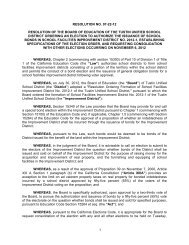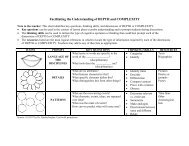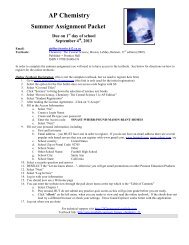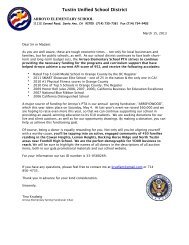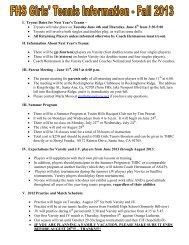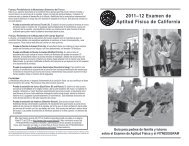College Planning - Tustin Unified School District
College Planning - Tustin Unified School District
College Planning - Tustin Unified School District
Create successful ePaper yourself
Turn your PDF publications into a flip-book with our unique Google optimized e-Paper software.
glossary<br />
Loan<br />
A type of financial aid that must be repaid, with<br />
interest.<br />
Master Promissory Note (MPN)<br />
To borrow under the federal loan programs,<br />
a student or parent must sign this common<br />
form. The MPN allows borrowers to receive<br />
loans for a single academic year, or for multiple<br />
academic years without having to sign a new<br />
note.<br />
Merit-based aid<br />
Financial aid awarded on the basis of grades,<br />
test scores, athletic ability or other talent<br />
regardless of a family’s income or assets.<br />
Need-based aid<br />
Financial aid awarded based on the family’s<br />
ability to pay for college. The FAFSA is typically<br />
used to determine a family’s eligibility for needbased<br />
aid.<br />
Part-time student<br />
An undergraduate student who is enrolled for<br />
fewer than 12 credit hours per semester or<br />
equivalent. A graduate student who is enrolled<br />
for fewer hours than the college’s standard to<br />
be considered a full-time student. Does not<br />
include audited courses.<br />
Personal expenses<br />
One of the typical components of Cost of<br />
Attendance (COA). Each college includes an<br />
average estimated cost you may incur for<br />
purchasing personal items such as laundry<br />
detergent, toothpaste, etc.<br />
PIN (Personal Identification Number)<br />
A four-digit number that is used in combination<br />
with a student’s Social Security number,<br />
name, and date of birth to identify someone<br />
who has the right to access the student’s<br />
personal information on Federal Student Aid<br />
websites, such as FAFSA on the Web. Parents of<br />
dependent students will also electronically sign<br />
a FAFSA and need their own PIN.<br />
Principal<br />
The dollar amount borrowed on which interest<br />
is calculated.<br />
Priority filing date<br />
The date established by the college by which<br />
students are encouraged to submit their FAFSA<br />
and have the results forwarded to the college<br />
to increase their chances of being awarded<br />
certain campus-based financial aid. Financial<br />
aid funds are limited for students who fail to<br />
meet their college’s priority filing date.<br />
Private grant aid<br />
Non-college grant aid, such as scholarships<br />
from community groups and organizations, that<br />
does not require repayment.<br />
Private loans<br />
Education loan programs provided by private<br />
lenders to supplement the student and parent<br />
education loan programs available from the<br />
federal government.<br />
Promissory note<br />
The legal document signed by the borrower<br />
prior to receiving a loan. States a promise<br />
to repay the loan, and lists the conditions<br />
of the loan and terms for repayment. The<br />
Master Promissory Note (MPN) is one type of<br />
promissory note.<br />
Room/board<br />
One of the typical components of Cost of<br />
Attendance (COA). Each college includes the<br />
actual cost it charges if you live on campus, or<br />
an estimated cost you may incur for living off<br />
campus.<br />
Satisfactory Academic Progress (SAP)<br />
The academic standard you must meet in<br />
college to continue to receive federal financial<br />
aid. Each college establishes its own SAP policy<br />
to comply with federal requirements.<br />
State grant aid<br />
State financial aid, such as grants and<br />
scholarships, that does not have to be repaid.<br />
Student Aid Report (SAR)<br />
The SAR summarizes the information you<br />
included on the Free Application for Federal<br />
Student Aid (FAFSA). The SAR provides the<br />
Expected Family Contribution (EFC), which is<br />
used to determine whether a student is eligible<br />
for a Federal Pell Grant and other federal aid.<br />
Title IV school code<br />
The Title IV school code is a six-character<br />
college identifier used for federal student aid<br />
programs. This code may have a two-digit suffix<br />
that identifies a particular division, campus or<br />
branch of the college.<br />
Transportation<br />
One of the typical components of Cost of<br />
Attendance (COA). Each college includes an<br />
average estimated cost you may incur for<br />
transportation to and from school. This can<br />
vary depending upon whether your permanent<br />
residence is in another city/state or if you are a<br />
commuting student.<br />
Tuition/fees<br />
One of the typical components of Cost of<br />
Attendance (COA). This is the actual cost<br />
the college charges students for providing<br />
instructional and other services. Tuition<br />
may be charged per term, per course or per<br />
credit hour.<br />
Undergraduate student<br />
A student who is enrolled in an undergraduate<br />
course of study that usually does not exceed<br />
four years and that typically leads to a degree<br />
or certificate.<br />
Unmet need<br />
The amount of need remaining after Expected<br />
Family Contribution (EFC), grant aid, and selfhelp<br />
are subtracted from Cost of Attendance.<br />
Verification<br />
The process colleges use to ensure the<br />
accuracy of the information reported on the<br />
FAFSA. You may be required to provide the<br />
college with a copy of your tax return or other<br />
additional documentation.<br />
27




